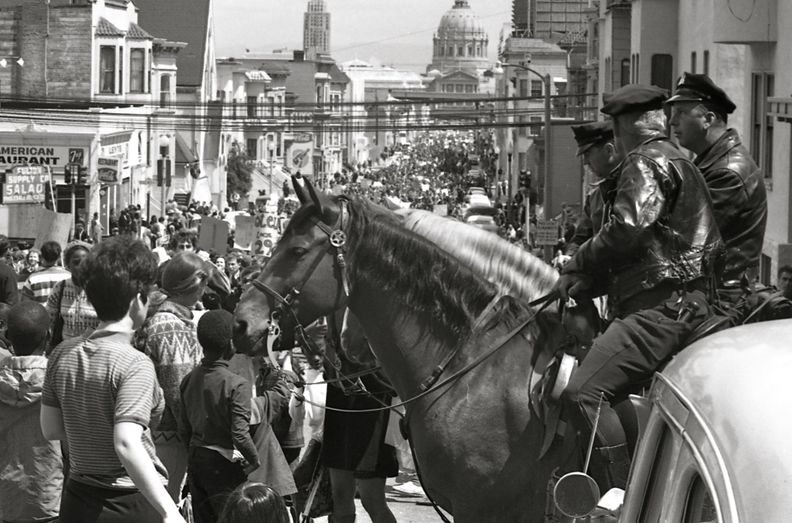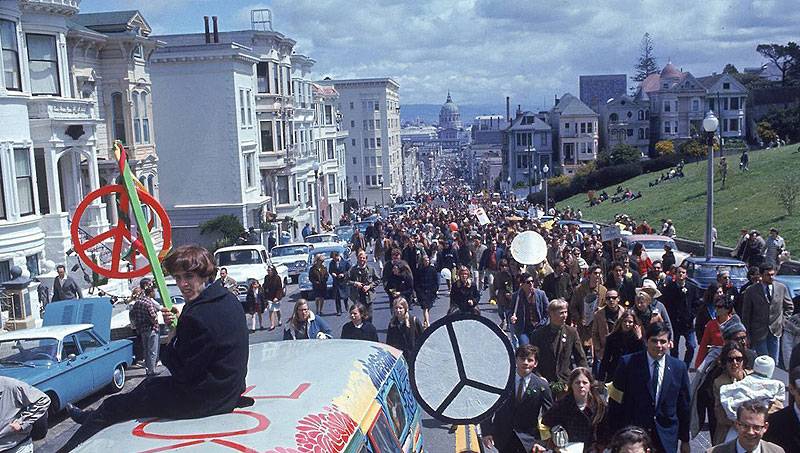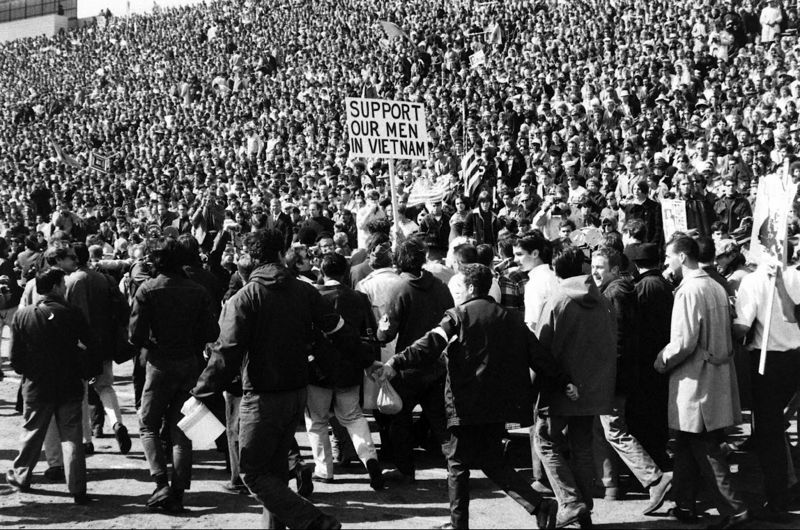The Spring Mobilization Committee to End the War in Vietnam, 1967
Historical Essay
by John Penilla
A pamphlet distributed by the National Committee advertising the day of action.
Photo: Peace Tour
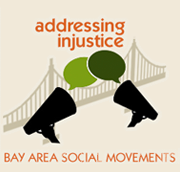
| The Spring Mobilization Committee to End the War in Vietnam led a historical mass demonstration on April 15th, 1967 that brought over 500,000 people out onto the streets of New York City and San Francisco. A close analysis reveals that the Committee adopted a two-pronged strategy, which combined mass coalition work with local community organizing strategies. The events also offer a window into the political debates and discords of the old and new left, particularly surrounding the question of how to involve ‘everyday’ Americans in the antiwar movement. |
In 1966, students, unionists, Blacks, Women’s organizations, Third World communities, and other oppressed constituencies were mobilizing against the Vietnam War. The Spring Mobilization Committee to End the War in Vietnam tasked itself with solidifying and harnessing the coalitional force of these groups, in order to mobilize two mass rallies on April 15th, 1967: one in New York and the other in San Francisco. Each group in the coalition had distinct interests, and thus conflicts were a regular occurrence; but the general intent and target were the same: building popular resistance against the actions of the United States government through a dual strategy of mass action and local community organizing.
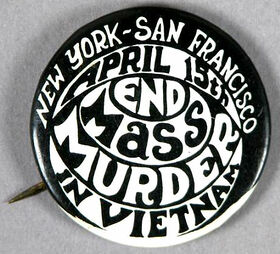
Button, courtesy Oakland Museum of California
This entry attempts to capture the voices of those who contributed to the mobilization’s successes and shortcomings, while cueing activists on the effectiveness of mass mobilization work. The first part of this entry will be dedicated to an overview of the political development of the nationwide coalition before it began to work locally in San Francisco. Next, the discussion will move to an examination of the work it carried out, with a case study on the role of unionists, particularly the International Longshore and Warehouse Union (ILWU).
“5. The Spring Mobilization Committee shall be charged with suggesting, stimulating, and/or organizing such actions of a more limited and more localized nature as may be feasible, with the aim of broadening the influence of the peace movement as much as possible, as long as these actions clearly fall within the consensus reached by the diverse viewpoints at this conference.” [1]
The committee emerged from the November 8th Mobilization Committee, and was cemented at the Cleveland Conference on November 26th, 1966. The conference was called by the Executive Council of the Inter-University Committee for Debate on Foreign Policy to debrief the anti-war demonstration they took place in on Nov. 5th-8th. Approximately 150 people attended the Cleveland Conference, with representatives from a variety of political perspectives, including the liberal-left, pacifist, and far-left; with organisations including the Socialist Workers Party (SWP), the Communist Party (CP), Students for a Democratic Society (SDS), Young Socialist Alliance (YSA), and the Du Bois Club.
Mounted policemen watch a Vietnam War protest march in San Francisco, April 15, 1967.
Photo: George Garrigues
A. J. Muste was chosen as Chairman of the National Mobilization Committee because he “earned the respect of virtually every sector of the social protest movements in this country, displaying leadership in his work as a pacifist, radical, labor and civil rights [activist].” [2] He recounts the conference in the first issue of their bulletin, The Mobilizer, discussing the debates that arose regarding mobilization strategy. At the outset of the convention, mass action was not necessarily a guaranteed strategy, though we see some clear support for this tactic in The Mobilizer, with some attendees stating: “that the anti- war movement needed and could mount the greatest demonstration ever of Americans against the abomination being perpetrated in Vietnam by the government of this country.”[3] The YSA were explicit in their call for mass organization and education, with their pamphlet arguing that “the continual educational campaign against the war, culminating in periodic mass demonstrations, has had a deep effect on the entire American public.”[4] Fred Halstead, a leader of the SWP, attended the conference, and elaborated on his account of the antiwar movement in his book Out Now!. Halstead explains that the SWP, CP and the Du Bois Club were all of a similar opinion to that displayed by the YSA regarding the efficacy of mass organizing.[5]
Other groups, particularly within the SDS, “emphasized the need for work on the local level, geared toward tackling the problems of everyday people and thus developing a truly democratic ‘power base for radical action.”[6] In response to the differing strategic affinities and concerns of the various groups, Muste—in his capacity as Chairman of the Committee—neatly synthesised the two positions together into something agreeable. He explained that “experience has often shown that local groups emerge as some national rally or action is projected,” and that “no national action can possibly attain significant proportions unless an immense amount of local concern and backing are available.”[7] Thus, a symbiosis of national and local organizing was adopted by the Committee.
A Pamphlet advertising the April 15th mass demonstration.
Photo: Pinterest
Having reached some level of agreement regarding strategy, the need to establish broad support for the coalition came to the fore. The first publication of The Mobilizer emphasises this, as Muste ensures he details the various discussions taking place at the Cleveland Conference in order to involve as many people as possible. Initially, he made it clear that there are many different expressions of the peace and antiwar movement and that their coalition does not represent them all. Given this stance, those in attendance debated about how to expand their base. One perspective, which ultimately did not carry, was committed to mobilizing ordinary Americans, believing that they are “well-meaning but ill-informed about what is going on in Vietnam.”[8] This perspective insisted on dropping the coalition’s non-exclusion policy: a policy which allowed for political radicals, particularly those on the far-left, to participate openly in the coalition, as they believed that everyday Americans would be reluctant to become involved in the coalition if radicals were present.[9] Muste, and those with similar sentiments, pushed back against this position, not because he believed the movement to be “superior to ‘ordinary Americans,’” but because he believed that these seemingly-apathetic Americans would be more active if integrated into groups and organizations.[10] This viewpoint thus inferred that the coalition’s organizing efforts would provide an environment that would bring these two groups together. For example, the Spring Mobilization committee would reach out to other groups (Churches, Third World groups, etc.) on the basis of their overall intent and not on the political and ideological persuasions of coalition members. Muste was clear about his support for “‘non-exclusion’ [to not be] tampered with in any way”[11], arguing that the principle contributes to the promotion of democracy in the United States, and explaining that any noncommunist coalition runs the risk of becoming anti-communist.[12]
Soon after the Conference, Rev. James Bevel became the National Director of the committee. This decision was politically savvy as Bevel had connections to the Civil Rights Movement, for he was a leader in the Southern Christian Leadership Conference (SCLC) and had close ties to Martin Luther King Jr. Bevel was also firmly on-board with the strategy to build the broadest coalition possible, with The Mobilizer highlighting remarks he made at a national committee. Bevel’s remarks revealed that he did not think that a peace organization would be as effective as a “protest group”[13], arguing that a protest group would be effective “when they force other groups, basically conservative groups,” to mobilize.[14] Key to his strategy for building the mass action was what he called establishing “the movement to end the mass murder.”[15] He believed a mass movement would be critical in mobilizing the ‘everyday Americans’, particularly in the black community, but also white liberals. To do this, Bevel was insistent on what he called “taking the position of the slave.”[16] This involves avoiding the use of a political argument to talk about the war; instead, he advocated for the adoption a moralistic one, urging people to take “a position based on humanity and decency,” which involves putting oneself in the position of those sent to war. This included the African American men fighting for the U.S. Army, but also the Vietnamese who were being murdered overseas. [17] He thought that this appeal to morals would be an effective means to mobilize everyday folks because—undoubtedly informed by his experience as a preacher—it creates a situation where “there ain’t no debate”, since everyone is against murder.[18] Also, the position of the slave effectively responds to the argument of white liberals who call for the bombing to end but support the commitment of more ground troops. However, maintaining the war in any way, whether it be through bombing and/or sending in more troops, is unacceptable when one takes the position of the slave.
As for the overall sentiment of the coalition, there was general support for the concept of self-determination. In an interview Kipp Dawsom, then leading member of the SWP and Executive Director for the West Coast mobilization, explained the main political line of the coalition was to focus on getting the troops out of Vietnam, and the rest of Indochina, because it was a civil war that the U.S. had no role in.[19] The YSA expanded on this, putting forward that that the movement was based “on self-determination, [and] it has let those in the oppressed colonial countries know that there are growing numbers in the U.S. who support their struggle for national independence.”[20] Bevel held the same line, but he added that the war directly contributed to racial oppression in the U.S. and abroad, particularly for African Americans, as white liberals were pushing the war in a direction that led to the murder of black people. To Bevel, their argument of more ground troops and not bombs was parallel to, “‘we believe we ought to be the slave masters, but we just ought to be kind slave masters.’”[21]
The success of the coalition is evident thus far. Their strategy resulted in a compromise amongst the left, preserving their ability to work together (which is no small accomplishment) and build a powerful political coalition. Moreover, they produced an effective strategy of local and national coordination. Dawsom explains that a solid national coordination was “essential” because it allowed them to represent the antiwar movement as a cohesive coalition, which opened the door to funding, other groups joining, and legitimacy. As a result, she argued that these factors led to one of the most important parts of the mobilization: Martin Luther King agreeing to speak at the East Coast mobilization.[22] Though this paper will not go into depth on this subject, it must be noted that impact of King’s supporting of the antiwar movement was momentous, due to the broad political support he had at the time.
The West Coast Mobilization
The West Coast mobilization, founded on the strategy of mass action through localized organizing, was led by Edward Keating of Ramparts magazine, who was chairman for the region, and Dawson—who said her main role was to facilitate building a broader coalition in the region.[23] The practical element of movement-building on the West Coast was signified by an announcement for a call to organize featured in the second issue of The Mobilizer, which informed readers about a West Coast antiwar conference that was to take place in San Francisco at 55 Colton St. The purpose of the meeting was to decide how they were going to put into practice the local-national strategy, with a mind to maximizing the turnout and organizing for the lead-up, and day of, the April 15th demonstration.[24]
Crowds march through San Francisco on April 15th, 1967
Photo: Old News Co
A similar view of the same march.
Photo: via John Harris facebook page, originally Life Magazine
It is important to note that the announcement in The Mobilizer reminded local groups affiliated with the Spring Mobilization Committee that they could use their own themes to organize various constituents. Keeping this in mind is critical because it allowed the organizing group to preserve their identity within a broad coalition. Also, the announcement stipulated that all groups must send one voting delegate and any amount of observers to the conference. The conference was expected to have representatives from Seattle, San Diego, and Denver, while members that had already sponsored the action in the Bay Area were to be there representing local religious groups, trade unions, academia, and civil rights groups.
The West Coast conference gives us an insight into the localized tactics used for the West Coast mobilization, which are consistent with the political vision of the Spring Mobilization Committee. The Student Mobilization Committee, an organizing committee within the broader coalition consisting of students from high schools and colleges around the nation, attended the meeting and reported - in their bulletin titled The Student Mobilizer - in an article titled “500 AT COAST PARLEY.”[25] They reported that the West Coast mobilization solidified their strategy, which would consist of a combination of local and mass action tactics. “There [would] be a protest march in San Francisco followed by a rally,” and “there [would] be a two week period of local anti-war actions culminating to the San Francisco rally on the 15th.”[26] The document titled “Activities Approved by the February 4th Conference” had at least fifteen “activities” or tactics approved to turn-out folks for the demonstration.[27] There are two main categories of tactics listed in the document: the first were general tactics that sought to increase the turnout for the mobilization from cities across the West Coast, while the second type focused on bringing out specific communities. General tactics discussed in the list include holding mass meetings on college campuses with well-known speakers, having press conferences bringing together antiwar leaders to post demands on the doors of city halls across the region, and to have local artists showcase antiwar pieces they created from March to April 1st; after which, they would be sent to SF to be displayed at Angry Arts Week West from April 7th to April 14th.
Demonstrator outside of Kezar Stadium.
Photo: Ralph Crane, Time/Life
Case Study: Bay Area Trade Unions
A specific community-oriented strategy and political vision that was taking place in the Bay Area
Labor had a significant presence at the conference, with approximately 60 unionists in attendance, and a labor workshop strategized tactics that would bring out their communities. One of the tactics decided on at the conference was to have resolutions of support passed in their locals for the April 15th Mobilization.[28] In the approved activities document list, another tactic proposed was to “encourage delegations of trade unionists to the Governor and Legislative leaders of each state requesting the appointment of a state commission to plan for converting industries from war to peacetime production,” asking them “‘what happens when peace breaks out?’”[29] In response, the strategy of the West Coast Conference was successfully followed through in some of the big trade unions: resolutions were passed by the UAW with President Walter Reuther openly stating, “‘I am opposed to further escalation,’” the United Packing House Workers’ resolution demanded that the US government “‘call an immediate ceasefire and begin negotiations,’” and Frank Rosenblum, General Secretary of the Amalgamated Clothing Workers, called for the US to not be concerned with “embarrassment” and withdraw.[30] Other major endorsements came from the Santa Clara County Central labor Council who agreed to participate at the San Francisco mass action. The district director of the International Packinghouse Workers Union and California State Federation of Teachers (AFT) endorsed the mobilization. United Auto Workers (UAW) Secretary Treasurer, Emil Mazey, agreed to speak at the rally, while the largest AFT local in New York voted to disassociate with the Executive Council of the AFL-CIO’s statement for not withdrawing their support of the war.[31] Rosenblum went so far as to criticize George Meany, President of the AFL-CIO, for removing Vietnam Day Committee demonstrators from their convention for challenging his so-called “enthusiastic support for Johnson’s war.”[32]
In the third edition of The Mobilizer, published on March 18th, labor made the front page with a powerful article titled “Union Leaders Join Mobilization.” For the labor movement, the political reasons for opposing the war were closer to home than advocating for the self-determination of the Vietnamese people. The President of the Negro American Labor Council took the position of vice-chairman of the Spring Mobilization Committee. His rationale was that the war was “morally compromising our country and wasting the resources, both human and material, which should go to provide an abundant and decent life for all Americans.”[33] The same sentiment was reported by Labor Committee chairman Paul Latz of Teamsters #85, in a summary of their progress to the Nation Committee of the Spring Mobilization Committee a month after the Conference on March 31st. This report is also significant because it captures the political vision and strategy for the West Coast. Latz explains “the main concern of all was how to mobilize a citizens’ effort to end the war” with the initial task “for our government to stop bombing and enter into a serious effort to negotiate.”[34] He continues and elaborates, explaining that the immediate impacts on the working people will be felt “in higher living costs, higher income and property taxes and interest, while the building trades and other non-military trades suffer from unemployment[,] corporations’ profits in the war industries have soared[,] the [Taft- Hartley Act] is being used increasingly to halt strikes in the guise of “‘Patriotism’” and the war.”[35] Being suppressed by injunctions on strikes was a high and relevant concern for those in the labor movement: the International Brotherhood of Electrical Workers (IBEW) received an injunction ending a four month long strike by shipyard electricians, and as recent as March 12th a similar fate befell 1,500 switchmen working on the Southern Pacific Line.[36] Ultimately, Latz sums up his message with “labor is under attack” and implores “unionists and citizens” to embrace and build for the SF mass action.[37]
That said, ending the war was in the immediate interest of their membership. On the West Coast pamphlets titled MARCH WITH LABOR, printed in March by the Labor Committee to End the War in Vietnam, provided statistics on the impact of the war. The connection was made in a short excerpt, explaining that increased federal income taxes would mean wage cuts, as the government would attempt to recoup the costs of war. Moreover, another section of the pamphlet is dedicated to displaying how these attempts at recouping costs would not be adequate because the war had already been far too costly. The Office of Education lost $233 million, Loans for Elderly lost $125 million, and Economic Development lost $330 million.[38]
When it came to mobilizing members for the April 15th San Francisco demonstration, the International Longshoremen and Warehouse Union (ILWU) were an exceptional case in the labor movement, with their historically-left leadership and rank-and-file militancy setting them apart from the rest of the unions involved in the mobilization. In Northern California, the District Council voted on February 20th to to endorse the Mobilization, thus securing support from Local 6, 10 and the unions auxiliary.[39,40] Not limiting themselves to an endorsement, they took an active role in the leadership for the Mobilization. Local 6 Head Business agent Paul Heidi was a part of the Spring Mobilization Executive Committee, contributing to discussions in labor forums during Vietnam Week that asked, “How widespread is labor’s opposition to the war?,” “What can labor do to affect U.S. foreign policy?,” and “Will the opposition continue to grow? Why?”[41] The “ILWU Policy Statement on Vietnam” immediately confronted President Johnson and his backers in Congress “to stop the killing in Vietnam.” They proposed next steps for the administration to implement: this included a ceasefire to facilitate negotiations, since no talks could be had if there were open conflict, withdraw American troops because if not then “mutual destruction” will result, and they demanded a settlement for peace.[42]
On the day before the march, Local 10 sent out a special Local 10: Longshore Bulletin to remind members, and make one last effort to turn their membership out for the next day’s march. One side of the bulletin, titled “Let’s March,” explained that the ILWU would be leading the labor division of the march, while also providing logistical details about how the day would look in relation to the workplace.[43] One issue the bulletin addresses is that the A and B men that come to the march will not be “flopped,” as long as they sign-in at the demonstration and “receive a member meeting stamp.” Nevertheless, the bulletin concretely reminded its membership that the purpose of the “the MARCH is to stop the slaughter of our men, slaughter of the Vietnamese, and to end the war.” What is also interesting about the bulletin is that on the back it provides an elaboration of one of the points of discussion at their 17th Biennial Convention of the ILWU & Warehousemen’s Union that was taken from a Report of the Officers. This discussion, under the title of “More from ‘the Convention,’” is responding to a critical question about what the role of the union is, especially in relation to the antiwar movement.[44] This is an invaluable discussion to remind members of a day before a mass demonstration because it provides the context for understanding the purpose of the ILWU generally, and specifically in the antiwar movement. The document explains why the ILWU has been so involved in organizing by making the distinction between a business union, whose purpose is only to oversee the contract, and militant progressive unionism that “see the unions as a way of life as the most effective weapon of the [worker] to tackle issues which control them all the way from legislation to quality of education …, and many other challenges of living.” The most important message for members to take away is that the membership is the power of the union, setting the agenda and creating legitimacy for their political program. But, if members do not get involved then their political program has no more weight than a “poker club” or neighborhood bartender” since the rank- and-file is not shaping it. April 15th finally came, and the ILWU and labor played a significant role. A sense of what the organizers had in mind for San Francisco can be found in the Planning Committee’s minutes.[45] Many different speakers are in the program notes including Judy Collins, Mrs. Grace Newman of the Ft. Hood 3, Eldridge Cleaver, and Coretta King (Martin Luther King Jr. was speaking at the mobilization in New York). Labor, and particularly the ILWU, had—and was intended to have—a major presence on the schedule. Paul Schrade of UAW was a scheduled speaker, and there are many notes typed and handwritten on the document to confirm a speaker from the ILWU. Whether it be Harry Bridges or another representative, space was made for them in the speaker schedule.
April 17, 1967 Spring Mobilization press scrum at Kezar Stadium.
Photo: Ralph Crane, Time/Life
Crowds gather at Kezar Stadium in San Francisco.
Photo: Old News Co.
Pro-war demonstrators managed to enter Kezar Stadium, but were ushered out by the vastly larger anti-war crowd.
Photo: Ralph Crane, Time/Life
The success and scale of the rally was huge; there are combined figures of approximately 500,000 that came out for the Mobilizations, with 400,000 in New York and over 100,000 in San Francisco.[46,47] There were many components of the local organizing that must be celebrated. The first is the use of the conference as a space for collective strategizing, for it allowed concrete local results such as union members getting resolutions passed in opposition of the war in their Locals. The importance of unionists calling out and refusing to support the Johnson Administration and the Meany regime was momentous, for it demonstrated the consciousness that the administration had been consistently overlooking workers’ interests in favor of those in the capitalist’s party. Another major success was the overall turnout for the demonstration. The numbers speak for themselves – it was definitely a mass action that certainly had a profound impact on those involved in building it, but also on the national conscious. The final success was that the coalition continued its organizing. Throughout the planning of the Spring Mobilization, on both the East and the West Coast, next steps were constantly being considered, and the next Conference was to take place May 20-21st, 1967 in Washington, D.C. to assess April 15th, improve the operations of the movement, and plan for new organizing efforts.[48]
Notes
[1] Spring Mobilizing Committee to End the War in Vietnam, The Mobilizer to End the War in Vietnam, “Documents from Cleveland,” pg. 2, vol. 1, issue 1, December 19, 1966, Box 7, Folder 12, Paul Covin Papers, Holt Labor Library, San Francisco, CA.
[2] Mobilizer, “A. J. Muste (1885-1967),” p. 6, vol. 1, issue 3, March 18th, 1967.
[3] Mobilizer, “Cleveland and After,” p. 5, vol. 1, issue 1, Dec. 19th, 1967.
[4] Young Socialist Alliance, "Is the Antiwar Movement Effective?" (New York City, NY: Young Socialist Alliance, 1967), pg. 3, Box 7, Folder 12 Paul Covin Papers, Holt Labor Library, San Francisco, CA.
[5] Fred Halstead, Out Now!: A Participant’s Account of the American Movement Against the War (New York: Monad Press, 1978), 208-9.
[6] Mobilizer, “Cleveland and After,” p. 5.
[7] Ibid.
[8] Ibid.
[9] Mobilizer, “Cleveland and After,” p. 6.
[10] Mobilizer, “Cleveland and After,” p. 6-7. 11 Ibid,7.
[12] Ibid 5,7.
[13] Mobilizer, “Bevel Directs Anti-War Mobilization,” p.3, vol. 1, issue 2, Feb. 6th, 1967, Box 7, Folder 12, Paul Covin Papers, Holt Labor Library, San Francisco, CA.
[14] Ibid.
[15] Ibid.
[16] Ibid.
[17] Ibid., 4.
[18] Ibid., 3.
[19] Interview with Kipp Dawsom by author, Dec. 15th, 2016.
[20] Young Socialist Alliance, "Is the Antiwar Movement Effective?", p,3.
[21] Mobilizer, “Bevel Directs Anti-War Mobilization,” p.3. 22 Interview with Kipp Dawsom by author, Dec. 15th, 2016. 23 Ibid.
[24] Mobilizer, “West Coast Mobilization,” p.5, vol.1, issue 2, Feb. 6th, 1967.
[25] The Student Mobilizer, “500 AT COAST PARLEY,” p.1, vol. 1, issue 2, Feb. 20th, 1967, Box 7, Folder 12, Paul Covin Papers, Holt Labor Library, San Francisco, CA.
[26] Ibid.
[27] “Activities Approved by the February 4th Conference,” Feb. 1967, Box 7, Folder 12, Paul Covin Papers, Holt Labor Library, San Francisco, CA.
[28] The Student Mobilizer, “500 AT COAST PARLEY,” p.1.
[29] “Activities Approved by the February 4th Conference,” 1967.
[30] Labor Committee to End the War in Vietnam, “March with Labor,” p.1-21967.
[31] The Mobilizer, “Union Leaders Join the Mobilization,” p.1-2, vol. 1, issue 3, March 18th, 1967.
[32] Campus Friends of AFT, “Labor is Marching on April 15th Against the War in Vietnam,” 1967.
[33] The Mobilizer, “Union Leaders Join the Mobilization,” p.1-2
[34] Paul Latz, Spring Labor Committee to End the War in Vietnam, “(Progress Report),” March 31st, 1967.
[35] Ibid.
[36] Labor Committee to End the War in Vietnam, “escalation in viet-nam & against labor in u.s.,” 1967.
[37] “Progress Report” March 31st, 1967.
[38] Labor Committee to End the War in Vietnam, March with Labor, “Poverty Funds Gutted,” p. 2, 1967.
[39] Labor Committee, “escalation in viet-nam & against labor in u.s.”
[40] “Progress Report”
[41] AFT Local 1570, “Labor and the Vietnam War,” April 10th, 1967.
[42] Labor Committee to End the War in Vietnam, March with Labor, “ILWU Policy Statement on Vietnam,” p. 2, 1967.
[43] ILWU Local 10, Longshore Bulletin, “Turn to on April 15th: Let’s March,” April 14th, 1967.
[44] “More from the Convention.”
[45] Program Committee Minutes, April 4th, 1967.
[46] Fred Halstead, Out Now!: A Participant’s Account of the American Movement Against the War (New York: Monad Press, 1978), 285.
[47] San Francisco Chronicle, “Big Anti-War Rally Set Here,” Feb. 27th, 1967, Box 7, Folder 12, Paul Covin Papers, Holt Labor Library, San Francisco, CA.
[48] Spring Mobilization Committee to End the War in Vietnam, “A Call for a National Conference,” 1967.


